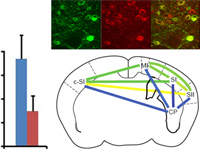Astrocytes are glial cells that interact with neuronal synapses via their distal processes, where they remove glutamate and potassium (K+) from the extracellular space following neuronal activity. Astrocyte clearance of both glutamate and K+ is voltage dependent, but astrocyte membrane potential (Vm) is thought to be largely invariant. As a result, these voltage dependencies have not been considered relevant to astrocyte function. Using genetically encoded voltage indicators to enable the measurement of Vm at peripheral astrocyte processes (PAPs) in mice, we report large, rapid, focal and pathway-specific depolarizations in PAPs during neuronal activity. These activity-dependent astrocyte depolarizations are driven by action potential-mediated presynaptic K+ efflux and electrogenic glutamate transporters. We find that PAP depolarization inhibits astrocyte glutamate clearance during neuronal activity, enhancing neuronal activation by glutamate. This represents a novel class of subcellular astrocyte membrane dynamics and a new form of astrocyte-neuron interaction.
